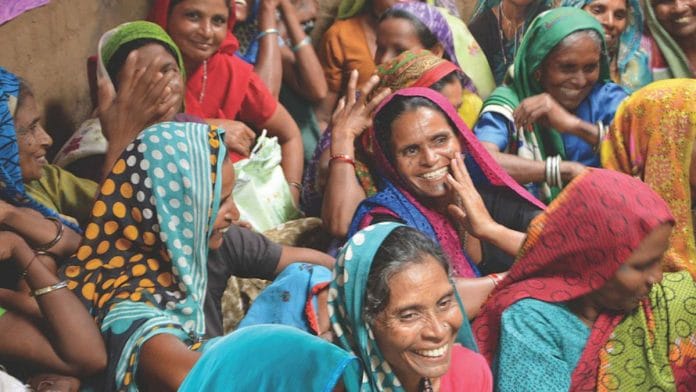India had over 63 million micro, small, and medium enterprises in 2020, half of whom are in rural areas, and approximately 20% of those rural enterprises are owned by women. These enterprises are accustomed to dealing solely in cash and when the COVID-19 pandemic struck, livelihoods were hit hard.
Making businesses digital would help these rural women merchants cope better with the current crisis and upcoming ones, tapping into new economic opportunities. However, they first need connectivity, including owning a mobile phone and having digital skills to manage mobile apps and online applications. These tools and skills are not evenly spread across communities. That’s why “Ending the gender gap in mobile phone ownership” is one of the 10 actions towards Reaching Financial Equality.
The recent Global Findex 2021 database showed that COVID-19 drove a large increase in use of digital payments amid the global expansion of formal financial services. Three-quarters of adults globally now have a bank or mobile money account and the gender gap in account ownership has narrowed. However, in India, it revealed that women with an account are still 18 percentage points less likely than men with an account to use digital payments. Digital literacy can help change that and organizations like SEWA can play a role.
Trade union is offering members digital payments training
A case in point is India’s oldest and largest trade union named Self-Employed Women’s Association (SEWA), who just joined the United Nation-based Better Than Cash Alliance as a member. SEWA seeks to improve the lives and livelihoods of its more than two million women members who work in the informal sector. These include seamstresses, artisans, vendors, and small and marginal farmers.
Under its online skilling academy – Manager in school – SEWA teaches its members about how to open a digital account and make transactions. This skill became key to Ganga Jayram Parmar’s business staying afloat and expanding during the pandemic.
Ganga runs a food ration shop in Zinjuvada village in India’s western state of Gujarat. Earlier she spent a lot of time counting cash, maintaining inventory and the cash registers. She often made calculation mistakes and had to spend time and hire someone to reconcile her accounts because she had studied only up to grade 7.
A training in mobile-based digital payments applications improved her life. Gaining knowledge and skills was a turning point. Now, she no longer has to manage, calculate, and deposit the cash in bank accounts. The time she has saved is helping her increase her business and boost her income. She now supplies food rations to seven other villages. “I feel liberated and have also taught my customers to pay using payments apps,” says Ganga.
SEWA has trained 400,000 women, knowing the journey to digital payments tends to start with skepticism. It is often the user’s first experience with digital finance. Most underserved users either distrust (or are unfamiliar with) digital payments. Therefore, digital payments need to work every time. Anything less and users quickly revert to cash.
The UN Principles for Responsible Digital Payments, by the United Nations-based Better Than Cash Alliance, serves as a practical guide for governments, companies and international organizations embracing responsible digital payments in their journey to building trust, mitigating risks and driving inclusive economies.
Responsible digital payments enable women to overcome structural and societal barriers. Meenaben Wajabhai Viramgama, another SEWA member explains, “I had to really struggle to find time and money to go to the bank. When there, I was nervous to fill up the slip in the presence of other customers and bank officials, mostly male. At home, I can do everything at my pace and convenience. The phone has brought the world to my doorstep.”
Digital payments app is building a network for women entrepreneurs
To demonstrate what designing for user’s needs (principle 5) means, SEWA worked with a fintech firm to build an app for its members called M-bachat (bachat means savings) which helps them digitally place orders for food supplies sold by SEWA members. The app is in Gujarati, and it underscores the importance of local language content for users to navigate easily, which helps build trust. To offer a digital marketplace to its network of entrepreneurs, SEWA has an online bazaar where rural women artisans can sell their products.
Today’s digital revolution is helping reach the 2030 Sustainable Development Goals more quickly. It is also challenging the notion that rural women are waiting passively for help. The ability to participate in the digital economy isn’t just life-changing for low-income women, it can also benefit economies. Digitalization of small and medium businesses could add anywhere between $158-216 billion to India’s GDP by 2024.
Digital payments app is building a network for women entrepreneurs
To demonstrate what designing for user’s needs (principle 5) means, SEWA worked with a fintech firm to build an app for its members called M-bachat (bachat means savings) which helps them digitally place orders for food supplies sold by SEWA members. The app is in Gujarati, and it underscores the importance of local language content for users to navigate easily, which helps build trust. To offer a digital marketplace to its network of entrepreneurs, SEWA has an online bazaar where rural women artisans can sell their products.
Today’s digital revolution is helping reach the 2030 Sustainable Development Goals more quickly. It is also challenging the notion that rural women are waiting passively for help. The ability to participate in the digital economy isn’t just life-changing for low-income women, it can also benefit economies. Digitalization of small and medium businesses could add anywhere between $158-216 billion to India’s GDP by 2024.






